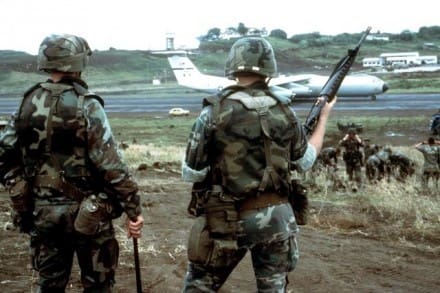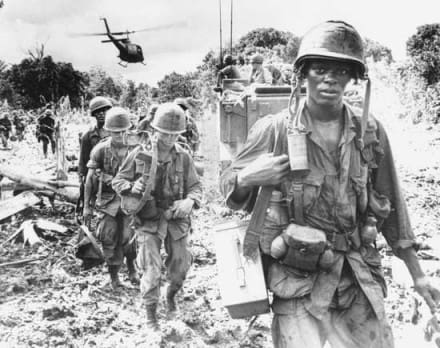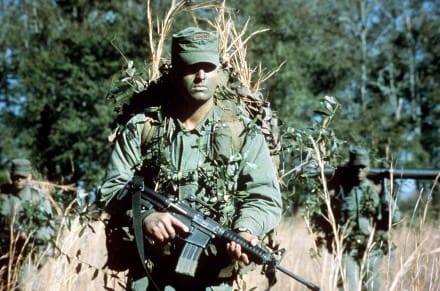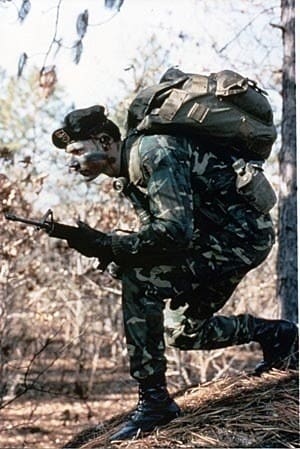From the outset, I have to say that technically, the Army is just looking for a new fabric, as there has been no talk (at least publicly) about developing a specialized uniform layout for tropical environments. However, in addition to a new jungle boot that we talked about last week, Natick has released a Sources Sought Notice entitled, “Light Weight Tropical Uniform“. This is excellent news.
To read the meat and potatoes of what the Army is looking for, see it here at RFITropWeight.
This is an interesting move as it is an admission that the current fabric used in the ACU, a 50/50 NYCO or nylon/cotton blend adopted for the Enhanced Hot Weather Battle Dress Uniform in the early 90s isn’t really much of a tropical weight fabric. Prior to this, Hot Weather BDUs were made from a 100% ripstop cotton fabric. This came about as the Army “rediscovered” the need for a tropical weight version of the BDU during the invasion of Grenada in 1983. The Army had begun fielding the Woodland camouflaged BDU, made from a heavy, 50/50 nylon/cotton twill in 1981. Designed for use in central Europe, they were too hot for hot weather use. However, the comfortable, quick drying, 50/50 NYCO poplin fabric of the HWBDU was to be replaced within a decade.
By the early 90s, a serious garrison mentality had taken hold in the US Army. Soldier were starching their HWBDUs and the process was wearing them out rather quickly, with fraying at the cuffs and collars in as little as six months. Instead of telling Soldiers to stop starching a uniform fabric optimized for tropical environments, the Army introduced a new fabric that would be more durable when starched and pressed under high heat. Unfortunately, this 50/50 NYCO fabric compromise fabric isn’t so great in the hot weather environments the uniform was intended for. The nylon content lowers breathability, making the fabric feel warmer. Operational capability was abandoned in favor of looking good in garrison. When the ACU came along, the Army incorporated that same 50/50 NYCO poplin fabric. Now that the Pacific Pivot is in, and the Army is scrambling to recreate capabilities like the jungle boot that it had abandoned years ago, it has dawned on somebody that they can find a better fabric solution and I am glad.
Granted, the Universal Camouflage Pattern is an issue in the jungle and Woodland EHWBDUs are will in use by some Army SOF and students at the new US Army Jungle School in Hawaii. Hopefully, the Army will work out a solution for this dilemma. But, we can always look back to a simple solution fielded during the Viet Nam War.
I’ve called it “The Greatest Uniform Ever Fielded By The US Army” and in my opinion, the OG-107 Jungle Fatigue in 100% ripstop cotton remains just that.
In fact, this uniform, as well as the ERDL camouflaged variant, continued to be worn well into the late 80s by Special operations Forces.
Rightfully so, the Army is looking, at a minimum (threshold), for a no-drip, no-melt solution fabric story. Naturally, if the star’s aligned (object) they’d like a full FR solution, although this is probably overkill considering the operational environment.
If you’ve got something that you think will work, the Army needs to hear from you by 1200EST on 08 May 2014. They’ll also need 5 yards of fabric (any color) and a the usual slew of technical data. Make sure you read the details in the amendments. The Army is going to use this data to help scope an actual requirement, making this is a very important part if the process.
With so much development in the textile industry over the past 10 years, here’s to hoping that the Army identifies a fabric optimized for use in hot-wet environments.
Tags: Natick






Three days gentlemen.
Three days.
It was originally released in March. I’ve been sitting on a draft for awhile hoping we’d see some fidelity on Camo before I posted it.
I would assume (making an ass out of you and me) that they already have a solution they are interested in (hence the three days to respond) and this is the fair and open part.
.This was released in March. I’ve just been slow on getting it posted.
Then that would be my mistake, thank you for the correction.
Only problem is that the same “Garrison mentality” is currently taking a stranglehold on the Army. But I do applaud whatever brass had the combat sense to go this route. I wish they would just have a garrison uniform so that combat uniforms could be as effective as possible.
I completely agree. But, it seems that the ACU is now effectively a garrison uniform
True the ACU is essentially a garrison uniform but I meant something more along the lines of a proper class B for daily wear. Kinda like what the Corps has. It would satiate the garrison whores and look “professional” while not screwing with a proper combat uniform.
You mean Khakis?
I wouldn’t mind seeing a “business professional” garison uniform like the old khaki uniforms. I honestly think this would be a good idea for say E7s and above who aren’t directly participating in a training event.
Getting completely off topic I think the DoD should adopt a common duty/utility uniform.
That’s too much common sense.
The future is board short material…a la Patagonia Jungle Uniform. Super comfy, like pajamas.
It’s comfy and yet, decidedly non-FR. I don’t think it’s even no melt, no drip. I’m not sure if it’s the answer.
Do you think FR/No Melt-No Drip is now a future requirement for all uniforms?
Or was the threat specific enough to two theaters that such a requirement may not be necessary in the future?
OR (sorry for the triple add on here); is the tech at such a place that FR tech incurs so little penalty in the fabric performance that there is no reason not to make all future combat uniforms FR?
Look at the Canadian uniforms, I had an opportunity to check out the uniforms going through the EOD school house, they had what looked like the lightest weight uniform I’ve seen. I don’t know how flame retardant it is though.
The CADPAT – desert material is great. Nylon, though, I think,
Its a non-FR, open waffle weave, 50/50 nylon-cotton fabric – IIRC
“Granted, the Universal Camouflage Pattern is an issue in the jungle”
Understatement of the century. 😉
+1
I sure did like the OG-107 jammies…..when they were phased out I bought all I could at clothing sales and wore them (sans insignia, of course) as civi gear.
That material is ideal for a tropical uniform.
And BTW, we knew in 1979 that a lightweight / tropical uniform was needed – during Bright Star. We had prototype BDU’s and they were horrible in Egypt.
Top picture…
Hondo?
Never mind, just hovered the cursor over it. I went to public school, forgive me.
Why not no melt / no drip Cocona?
I hope they respond.
Cordura’s base layer fabric seems interesting as well.
http://www.cordura.com/en/fabric/baselayer-fabric.html
Nice read. I remember the uber-comfy cotton BDU, and how much longer the “field” uniforms I never pressed lasted than the “garrison” uniforms that I wore in “spit and starch” mode. I also remember how brutal the NYCOs were before they faded.
Initial issue during basic gave me older all cotton tops and the new nyco bottoms. Did some pushing for it later on as the different color fades stuck out like a sore thumb. Later, I’d hunt through surplus stores for complete sets. So much better for field use. Plus the used tops would usually have a darker color or leftover glue from the previous insignia that helped a young snuffie when sent on battalion work details.
My best memory of the OG107’s was a FTX where our company was tasked as an opfor and told to wear something other than the current uniform. Most wore jeans and realtree or some other hunting cammo. One prior service squad leader comes in his old OG107’s and green canvas jungle boots. Looked like he was back in the 82nd long ago except he had sewn on his current rank insignia. Lots of attention and lots of ‘what kind of uniform is that?” from the young joes.
I loved the OG Jungle Fatigues, and the original 100% cotton hot weather BDUs. The nylon/cotton blend hot weathers sucked, so I went after-market.
I think it was Tru-Spec who had mil-spec cut hot weather BDUs, made in Honduras or Dominican Republic, these were 100% cotton, but seemed to be woven of a much THICKER COTTON THREAD than the official issue version. You could feel the fabric was somewhat more course. These uniforms wore MUCH longer than the issue 100% cottons, AND they seemed to breathe a lot better. Also, they completely blew away the nylon/cotton version.
Yup, Tru-Spec.
I wore those in successive OEF/OIF deployments, and have one set still serviceable enough for reunion range days.
Everyone can benefit from FR material whether they’re out fighting or in garrison dealing with life’s “what-ifs”. Serious car accident victims, those involved in any emergent situation, the list goes on. Almost no activity is much enhanced by clothing that burns easily, or sticks to you when it does.
Still, I remain unconvinced that clothing needs to be purposely FR, such as flight suits and so on. As expensive as that stuff is, it only protects you from flash fire. It ain’t bunker gear.
Cotton, wool, these materials are better to wear in any case than is nylon/polyester and so on, they have a very long track record of being able to be made comfortable and easy to care for, durability, and blah, blah, blah.
My ultimate dream is that one day the army will have people who pull their heads out of whatever orifice that it currently occupies, and get rid of the queermo unit patches, merit badges, names tapes, flags, and everything that isn’t your rank. All the pieces of flair are retarded, serve zero purpose, and just add one more thing to snit over. Oh, and Velcro needs to die a slow, painful death on any garment used in the process of hunting & killing foreigners.
Just sayin’.
If you want your name on your shirt, go work at Wendy’s.
/rant
http://multicampattern.com/multicam_patterns/
It’s pretty depressing that one single source vendor could answer most of the Army’s uniform problems yet they’re too stubborn and stupid to act. I guess you get what you ask for by detaching the fighter from the acquisition. When you do incorporate the frontline you get Crye. Just look at SF, 75th and all the other USASOC, JSOC elements.
I wasn’t in back during that time so I have limited knowledge on that type of environment. Cotton and rainy environments don’t really seem to mix, so why was it used? More breathable than nylon?
Yes, FR is most likely a requirement now, until a large AO proves that foot patrols are used exclusively and vehicles are mainly for transporting items in and out of a base/FOB and the FR is adding considerable weight/ or fatigue to the soldier load. Then they’ll do a rush job to find the best heat/wicking material for that based on how things are being run now
Cotton breathes VERY well. Nylon? Not necessarily as well. Plus, you have to look at the times it was selected in; 1960s. Nylon fabrics weren’t as sophisticated then as now. I’m looking forward to seeing what industry comes up with. And, what the cost-benefit-analysis drives the Army toward using.
Cotton dries “quickly enough,” especially when worn over a wool base layer (presuming you’re not allergic). But your point about newer materials is valid.
In terms of modern materials, one of the best FR t-shirts I’v ever owned is a pair of Under Armor FR t’s made from an Aramid knit. They seem only to have been made for a brief period, and I can only presume that Uncle Sugar and the user base balked at the painfully brutal ($70 for SS, $100 for LS) pricing, as Dri-Fire came in waay waay lower.
To this day, it’s some of my favorite (and probably least replaceable) gear. It would be interesting to see what could be done with this Aramid knit sewn to an Aramid weave in the manner of the combat shirts.
More Moronic Army uniform gobbledygook makes my head hurt. PEO soldier must be run by trained monkeys.
The Outdoor industry now has hydrophobic polymers as used in Dri-Down and Dri-Cotton. I could envision a comfortable OG-107 type of uniform that does not absorb water.
I’ve got a pair of the pants. So far, so good!
Love me some OG-107s
http://i999.photobucket.com/albums/af111/Vietnam_Airsoft_UK/M16/SuppressedM16.jpg
I’ve always loved jungle boots and lightweight uniforms. The hydrophobic cottons on the market today look very promising and others like Under Armours charged cotton could be ideal. Other folks have outlast climate control treatments in my theres. I can’t wait to see what comes out of this and their jungle boot research.
How does proppers 65/35 battle rip stack up compared to 50/50. Also I though people hates 100 cotton because it fades and wears out quickly
Poly cotton doesn’t just burn, it continues to burn even after you take the flame away. Horrible fabric for a combat uniform,
I agree that the old OG’s were a great uniforms, having wore them at FT Polk they worked and fit that environment pretty well. My thing is I don’t want to go back to Winter and Summer uniforms like we used to have. If these are hot weather/jungle orientated then the fabric type needs to be the standard or universal uniform fabric across the board. Pick the fabric, Pick a dam camo color and lets move on.
Simple solution: make the OG-107 Jungle Fatigues out of MC Tropic and be done with it. This uniform with updated jungle boots (gotta have a Panama sole!!) and any of Blue Force Gear’s “xxxxminus” gear and you will be GTG for jungle ops. If I had to do it again, this is what I would wear and use.
All I ever wore in the jungle was the CIF issued OG-107s. They were 100% rip-stop cotton without any reinforcements anywhere on them – the knee and elbow reinforcements on the EHWBDUs acted like sponges and never dried out and got pretty nasty after a few days. When they tore (they always tore eventually), one would just go and DX them at CIF. I think this is the key; a cheap uniform to make, field and dispose of.
The best there ever was….the Vietnam jungle fatigue. But true to fedgov bureaucracy and the military-industrial complex….they tried to re-invent the wheel.
Vietnam jungle fatigues….the best.
Again I though 100% cotton was a no no because it faded and wore out to quickly.
They are going to rot/wear out before they fade.
And isnt that a liability on a combat uniform. Also SSD you as of now run the uniform board for the entire military (including coast guard) whst change would you bring about in regards to current uniforms, material composition, camo patterns, types (creating a garrison uniform) ETC?